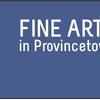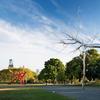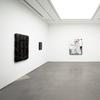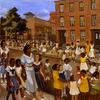LACMA to Show Seminal Works by Frank Stella, Including Many Out of Public View for 3 Decades
- LOS ANGELES, California
- /
- February 19, 2019
From May 5 to Sept. 2, 2019, the Los Angeles County Museum of Art (LACMA) will present Frank Stella: Selections from the Permanent Collection. Organized in loose chronological order, the exhibition features 10 works—many of which have not been on public view in over 30 years—that represent significant developments in the artist’s oeuvre. From an example of his groundbreaking Black Paintings of the late 1950s to his recent monumental sculpture, this exhibition will present a glimpse into the rich trajectory of Stella’s career. Drawn entirely from LACMA’s extensive holdings of Stella’s work, this exhibition assembles seminal examples of his artistic output that have never been shown together.
Frank Stella (b. 1936) has remained one of the most pivotal figures in the development of modern art since the 1950s. By the time he was 23, Stella’s art was already being recognized for its innovations. Several of his paintings were included in the 1959 exhibition Three Young Americans at the Allen Memorial Art Museum at Oberlin College, as well as in Sixteen Americans at the Museum of Modern Art in New York (1959–60). Composed of parallel bands of flat black paint separated by thin lines of unpainted canvas, Stella’s iconic early series Black Paintings (1958–60) were a radical departure from Abstract Expressionism, the movement that dominated art in the previous decade. Eliminating illusionistic space and narrative or symbolic allusions, this series called attention to the physical properties of paint and canvas, conveying Stella’s statement at the time that “what you see is what you see.”
Stella’s Irregular Polygon (1965–66) and Protractor series (1967–71) further extended the concept of the shaped canvas that he had begun exploring in the early 1960s, and they anticipate his increasingly complex investigations into geometry and
space that define his later work. In the mid-1960s, Stella also began his prolonged engagement with printmaking, working first with master printer Kenneth Tyler at Gemini G.E.L. in Los Angeles. Over the next decade, Stella’s “maximalist” painting
introduced relief into his art, which became known for its sculptural qualities. In the years that followed, Stella focused more on materials. His Polish Village series (1971–73), for example, incorporated wood, felt, paper, and other materials. Later
on, he began using aluminum as the primary support for his paintings and works in high relief. As the 1970s and 1980s progressed, these became more elaborate and exuberant. His earlier minimalism took on baroque qualities in his Exotic Birds
(1976–80), Malta (1983–85), and Scarlatti Kirkpatrick (begun 2006) series, marked by billowing and curving forms, DayGlo colors, and scrawled brushstrokes.
In the 1990s, Stella began making freestanding sculpture for public spaces and developing architectural projects. In 1992–93, for instance, he created the entire decorative scheme for Toronto’s Princess of Wales Theatre, which includes a 10,000-square-foot mural. In 1999, Stella’s aluminum bandshell inspired by a folding hat from Brazil was built in downtown Miami; and in 2001, a monumental sculpture Prinz Friedrich von Homburg, Ein Schauspiel, 3X was installed outside the National Gallery of Art in Washington, D.C. Stella continues to live and work in New York.













100x100_c.jpg)
